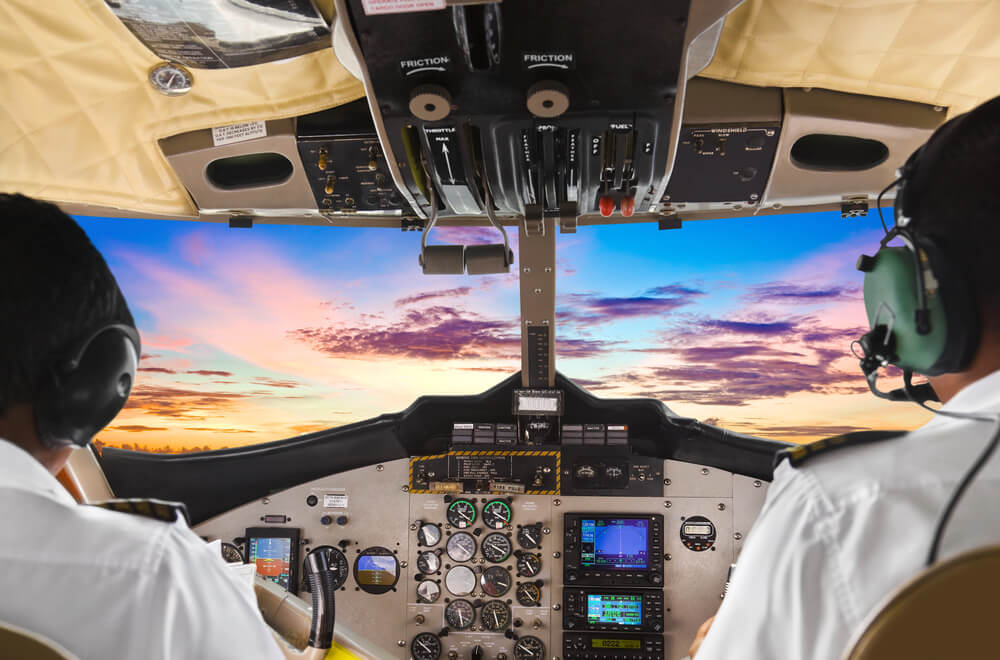Modern aviation faces a serious challenge: keeping pilots alert during flights. While advances in technology have made flying generally safer than ever, pilots, like all humans, face challenges like fatigue, typically resulting from disrupted sleep schedules. To stay awake, alert, and focused for long hours, pilots and aviation authorities employ a range of strategies.
This article sheds light on the various methods pilots use to stay awake and ensure passenger safety, including medications and other solutions. Let’s dive in.
What Is Pilot Fatigue?
One of the most critical challenges in modern aviation is understanding and managing what is known as pilot fatigue. Contrary to popular belief, pilot fatigue isn’t just about feeling tired; it’s a state of physical and mental exhaustion that can severely reduce an aviator’s ability to carry out their required tasks safely and effectively. It’s caused by factors like long hours of flying, irregular sleep schedules, and crossing multiple time zones. The most commonly reported symptoms include [1]:
- difficulty concentrating on tasks;
- slower reaction times;
- lapses in attention;
- forgetfulness;
- higher tolerance for risks;
- reduced decision-making ability;
- inability to anticipate events.
According to various studies, this type of fatigue typically affects cognitive performance and increases the risk of errors. The condition is particularly challenging on long flights across multiple time zones, where the natural sleep-wake cycle gets disrupted [2]. The combination of irregular schedules, night flights, and crossing time zones creates what experts call circadian rhythm disruption, making it even harder for pilots to maintain optimal alertness.
Airplane Accidents Caused by Pilot Fatigue
Pilot fatigue has been a major factor in several airplane accidents over the years. One notable case was the 2009 air crash involving Colgan Air Flight 3407, which claimed 50 lives. The National Transportation Safety Board (NTSB) noted that pilot fatigue was one of the reasons for the accident. The captain had taken only a short nap before the flight, and the first officer had traveled overnight, so neither of them had enough rest.
Another accident was the crash of Air India Express Flight 812 in 2010. Occurring in Mangalore, India, it claimed the lives of 158 people. The captain, who had slept for only a brief period before the flight, made big mistakes while attempting to land. Pilot fatigue was flagged as a major reason for the crash.
The 1999 crash of American Airlines Flight 1420 was largely attributed to pilot fatigue. The plane overran the runway while attempting to land during severe weather in Little Rock, Arkansas, leading to the deaths of 11 out of the 145 occupants onboard. The crash investigation pointed to fatigue as a factor, noting the captain had been awake for 16 hours that day [3].
These accidents prompted the Federal Aviation Administration (FAA) to make significant changes in aviation rules and regulations. For example, in 2014, the body implemented stricter rest requirements, such as a minimum 10-hour rest period before flights and a 30-consecutive-hour free period from duty each week. The FAA also sets maximum flight time limitations based on the time of day a pilot’s shift begins.
Pills to Help Stay Awake
One of the most well-known methods aviators use to combat fatigue, particularly on long-haul flights, is the use of wakefulness-promoting drugs. These medications, often referred to as “pilot’s salt,” have been part of aviation history for decades, especially in the US military and Air Force.
Some pilots take Adderall, among other stimulants, but modafinil (Provigil) is currently the most widely accepted medication. While the FAA-approved medications list for pilots is quite restrictive, modafinil is authorized for use in certain cases. Although it was originally developed to treat narcolepsy and other sleep disorders, it was later discovered to improve spatial planning and working memory, increase alertness and focus, and boost overall cognitive function.
The use of modafinil in the military dates back to the Gulf War, where it was used to keep pilots awake during long missions. Before modafinil, amphetamines like Adderall were commonly used. While effective, these drugs came with serious downsides, including jitteriness, dependence, poor decision-making, and potential long-term health issues. Modafinil is particularly favored because of its effectiveness, relatively low risk of dependence, and relatively mild side effects compared to other stimulants [4]. Its use has since expanded to civilian applications due to its cognitive-enhancing properties and ability to combat fatigue in non-clinical settings.
Although modafinil and similar meds have proven effective, their use raises some ethical concerns. Should pilots rely on medications to manage fatigue instead of addressing its root causes, such as inadequate rest or demanding schedules? Should they use them when flying commercial flights where passenger safety is important? Some argue that using wakefulness-promoting medications creates a false sense of safety, potentially leading to overconfidence and increasing risks.
Generally, the FAA only allows these drugs under specific conditions, and aviators must disclose their usage during medical evaluations. However, in military aviation, the stakes are often even higher than in commercial flights. Combat missions or reconnaissance operations can stretch for hours or even days, leaving little room for traditional rest. As a result, the US Air Force and other branches continue to rely on “smart drugs” like modafinil to ensure pilots can perform under extreme conditions.
Other Measures to Combat Fatigue
While medications like modafinil play a role in combating pilot fatigue, they are not the only solution. The aviation industry uses various non-pharmaceutical strategies to ensure pilots remain alert and capable of making critical decisions during flights. These solutions include both organizational and personal approaches [5][6]:
- healthy lifestyle practices: A healthy lifestyle is an essential aspect of fatigue management. Pilots are encouraged to maintain regular sleep schedules, eat nutritious meals, and stay physically active. Avoiding caffeine and alcohol before flights is also important, as these substances can disrupt sleep patterns and reduce overall alertness [7];
- tactical napping: One effective and widely used strategy to combat fatigue in aviation, particularly in military settings, is controlled rest in the cockpit, also known as tactical or “strategic napping.” This practice allows one pilot to take a short nap, usually around 20 to 40 minutes, while the other remains alert and in control of the aircraft. Research has shown that such naps can significantly enhance performance and reduce symptoms of fatigue during later stages of the flight, particularly if they don’t exceed 40 minutes [8][9];
- Fatigue Risk Management Systems (FRMS): To address fatigue, airlines are increasingly adopting FRMS. These systems use scientific data to design schedules that reduce pilot fatigue. Factors like flight duration, time zone changes, and the number of flights a pilot has are analyzed to create better flight schedules. FRMS also encourage pilots to report fatigue concerns without fear of repercussions, which improves safety;
- proper rest facilities: Long-haul flights often require pilots to rest mid-flight, especially on routes lasting more than 12 hours. To ensure pilots are comfortable enough to get quality sleep, some airlines have incorporated designated rest areas within aircraft, equipped with comfortable beds or reclining seats. These facilities ensure pilots are well-rested before taking control of the cockpit again.
While these strategies are effective, fatigue remains a complex issue. Pilots should combine these solutions with personal responsibility to manage their sleep and rest habits effectively.
So, How Do Pilots Stay Awake?
How do pilots stay awake on long flights? The answer lies in a combination of all the strategies and practices discussed above, especially during long-haul flights. Pilots use a mix of pharmacological aids like modafinil for critical situations and natural strategies like controlled naps, optimal sleep scheduling, and adherence to strict FAA rules. Modafinil helps enhance alertness and cognition not only for pilots but also for professionals across various fields where sleep is limited.
While the FAA permits modafinil use under certain conditions, stimulants like Adderall are generally not allowed because of their potential side effects and ethical concerns. The FAA continues to access medications for their safety and suitability for commercial pilots. With advancements in technology and fatigue management strategies, the safety of air travel will continue to improve.
References
- Pilot Fatigue. Retrieved: January 4, 2025. Wikipedia.org.
- Factors Contributing to the Risk of Airline Pilot Fatigue. By Seungyoung Lee and Jin Ki Kim. Retrieved: January 4, 2025. Sciencedirect.com.
- 16 Plane Crashes Caused by Fatigued Aircrew. Retrieved: January 4, 2025. Blog.predictivesafety.com.
- The Drug Pilots Take to Stay Awake. By Zaria Gorvett. Retrieved: January 4, 2025. Bbc.com.
- Fatigue in Aviation: Safety Risks, Preventive Strategies and Pharmacological Interventions. By Yara Q. Wingelaar-Jagt, Thijs T. Wingelaar, et al. Retrieved: January 4, 2025. Pmc.ncbi.nlm.nih.gov.
- 4 Tips on Combatting Pilot Fatigue. By Andre Fodor. Retrieved: January 4, 2025. Avbuyer.com.
- Self-Help Tips to Fight Tiredness. Retrieved: January 4, 2025. Nhs.uk.
- Strategic Napping. By Charles Moore. Retrieved: January 4, 2025. Thrivestreetadvisors.com.
- Pros and Cons of Strategic Napping on Long Haul Flights. By P.J.L. & M. Simons. Retrieved: January 4, 2025. Sto.nato.int.








